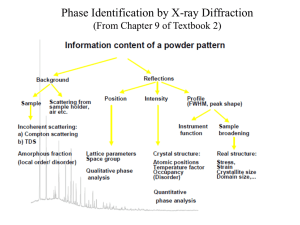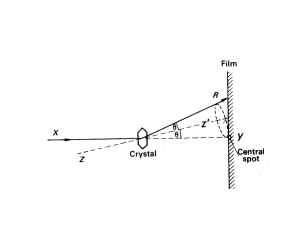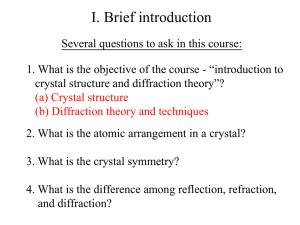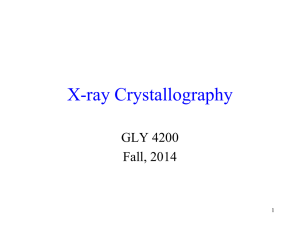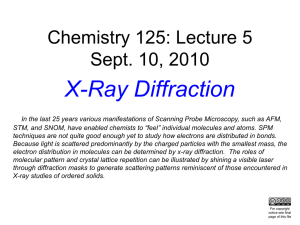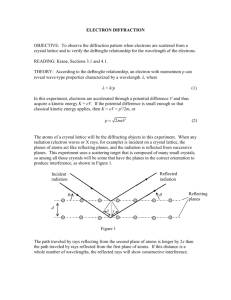V. Analyzing the SrTiO3 Powder Diffraction Data
advertisement
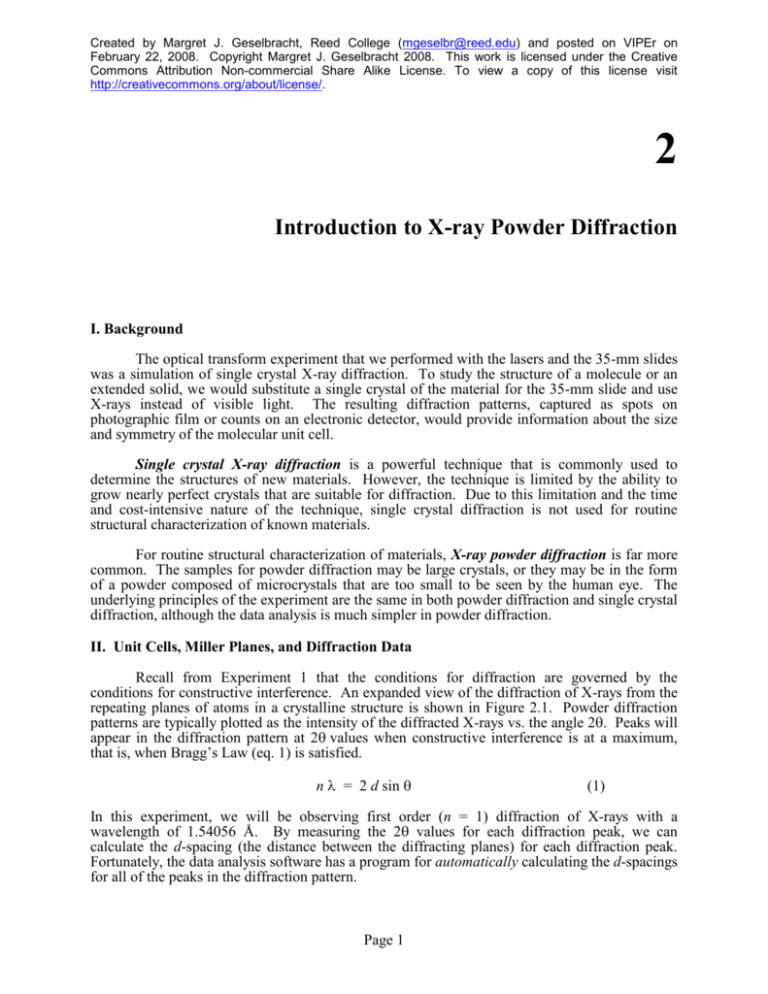
Created by Margret J. Geselbracht, Reed College (mgeselbr@reed.edu) and posted on VIPEr on February 22, 2008. Copyright Margret J. Geselbracht 2008. This work is licensed under the Creative Commons Attribution Non-commercial Share Alike License. To view a copy of this license visit http://creativecommons.org/about/license/. 2 Introduction to X-ray Powder Diffraction I. Background The optical transform experiment that we performed with the lasers and the 35-mm slides was a simulation of single crystal X-ray diffraction. To study the structure of a molecule or an extended solid, we would substitute a single crystal of the material for the 35-mm slide and use X-rays instead of visible light. The resulting diffraction patterns, captured as spots on photographic film or counts on an electronic detector, would provide information about the size and symmetry of the molecular unit cell. Single crystal X-ray diffraction is a powerful technique that is commonly used to determine the structures of new materials. However, the technique is limited by the ability to grow nearly perfect crystals that are suitable for diffraction. Due to this limitation and the time and cost-intensive nature of the technique, single crystal diffraction is not used for routine structural characterization of known materials. For routine structural characterization of materials, X-ray powder diffraction is far more common. The samples for powder diffraction may be large crystals, or they may be in the form of a powder composed of microcrystals that are too small to be seen by the human eye. The underlying principles of the experiment are the same in both powder diffraction and single crystal diffraction, although the data analysis is much simpler in powder diffraction. II. Unit Cells, Miller Planes, and Diffraction Data Recall from Experiment 1 that the conditions for diffraction are governed by the conditions for constructive interference. An expanded view of the diffraction of X-rays from the repeating planes of atoms in a crystalline structure is shown in Figure 2.1. Powder diffraction patterns are typically plotted as the intensity of the diffracted X-rays vs. the angle 2. Peaks will appear in the diffraction pattern at 2values when constructive interference is at a maximum, that is, when Bragg’s Law (eq. 1) is satisfied. n = 2 d sin (1) In this experiment, we will be observing first order (n = 1) diffraction of X-rays with a wavelength of 1.54056 Å. By measuring the 2 values for each diffraction peak, we can calculate the d-spacing (the distance between the diffracting planes) for each diffraction peak. Fortunately, the data analysis software has a program for automatically calculating the d-spacings for all of the peaks in the diffraction pattern. Page 1 Created by Margret J. Geselbracht, Reed College (mgeselbr@reed.edu) and posted on VIPEr on February 22, 2008. Copyright Margret J. Geselbracht 2008. This work is licensed under the Creative Commons Attribution Non-commercial Share Alike License. To view a copy of this license visit http://creativecommons.org/about/license/. Bragg diffraction d } d } } d sin d sin For constructive interference, 2(d sin ) = n Figure 2.1. Bragg's Law of diffraction is derived from the conditions set up for constructive interference at the detector of X-ray beams diffracting from parallel planes in the structure. Figure 2.2. A comparison of the X-ray powder diffraction patterns of NaCl (bottom) and KCl (top). Peaks in the KCl diffraction pattern are labeled with Miller indices, h k l, indicating the set of lattice planes responsible for that diffraction peak. The KCl peaks are shifted to lower angles relative to the NaCl pattern due to the larger cubic unit cell of KCl. Page 2 Created by Margret J. Geselbracht, Reed College (mgeselbr@reed.edu) and posted on VIPEr on February 22, 2008. Copyright Margret J. Geselbracht 2008. This work is licensed under the Creative Commons Attribution Non-commercial Share Alike License. To view a copy of this license visit http://creativecommons.org/about/license/. Each crystalline substance has a unique X-ray diffraction pattern. The number of observed peaks is related to the symmetry of the unit cell (higher symmetry generally means fewer peaks). The d-spacings of the observed peaks are related to the repeating distances between planes of atoms in the structure. And finally, the intensities of the peaks are related to what kinds of atoms are in the repeating planes. The scattering intensities for X-rays are directly related to the number of electrons in the atom. Hence, light atoms scatter X-rays weakly, while heavy atoms scatter X-rays more effectively. These three features of a diffraction pattern: the number of peaks, the positions of the peaks, and the intensities of the peaks, define a unique, fingerprint X-ray powder pattern for every crystalline material. For example, the X-ray diffraction patterns of the isostructural compounds NaCl and KCl can be compared in Figure 2.2. Notice that the two patterns are fairly similar. The relative intensities of the peaks differ, but the primary difference is that the diffraction peaks for KCl appear at lower angles, higher d-spacings, than those for NaCl due to the larger unit cell of KCl. X-ray powder diffraction is a powerful tool for characterizing the products of a solid state synthesis reaction. At the simplest level, diffraction patterns can be analyzed for phase identification, that is, determining what crystalline substances are present in a given sample. More quantitatively, the peak positions can be used to refine the lattice parameters for a given unit cell. Unit cells in three-dimensional repeating structures have different shapes based upon the symmetry of the structure. In all cases, the unit cells are parallelepipeds, but the different shapes arise depending on restrictions placed on the lengths of the three edges (a, b, and c) and the values of the three angles (, , and ). The seven different unit cell shapes or the so-called seven crystal systems that result from these restrictions are listed below in Table 2.1. Table 2.1. The seven crystal systems and the restrictions placed on the lattice parameters of the unit cell. Crystal System Lattice Parameter Restrictions Cubic a = b = c = = = 90˚ a = b ≠ c = = = 90˚ a ≠ b ≠ c = = = 90˚ a ≠ b ≠ c = = 90˚; ≠ 90˚ a ≠ b ≠ c ≠ ≠ ≠ 90˚ a = b ≠ c = = 90˚; = 120˚ a = b ≠ c = = 90˚; = 120˚ Tetragonal Orthorhombic Monoclinic Triclinic Hexagonal Trigonal* *The difference between trigonal and hexagonal systems is the symmetry. A hexagonal unit cell has C6 symmetry, whereas a trigonal unit cell only has C3 symmetry. The restrictions shown above are for the so-called hexagonal setting of a trigonal setting. There is an alternative way to define the unit cell for trigonal systems, known as the rhombohedral setting. Page 3 Created by Margret J. Geselbracht, Reed College (mgeselbr@reed.edu) and posted on VIPEr on February 22, 2008. Copyright Margret J. Geselbracht 2008. This work is licensed under the Creative Commons Attribution Non-commercial Share Alike License. To view a copy of this license visit http://creativecommons.org/about/license/. Each peak in a diffraction pattern arises from a unique set of repeating planes in the structure. These sets of planes are oriented in all different directions in three-dimensional space. However, in order to see diffraction from a specific set, the planes must be oriented relative to the incident X-ray beam in the manner shown in Figure 2.1. Therefore, X-ray powder diffraction relies on a large number of crystallites in random orientations in order to observe the most diffraction peaks. Of course, the proper orientation is only one factor. Diffraction from a particular set of planes may not be observed or the peak intensity may be low due to symmetry (patterns of systematic absences) or other factors that contribute to low intensity. How do we specify these different sets of planes in a particular structure? This is done by assigning a set of Miller indices (h k l), three integers that denote the orientation of the planes with respect to the unit cell. For a given set of planes, one plane in the set will intercept the unit cell at the following points along the three axes relative to the origin: c a b , 0, 0 and 0, , 0 and 0, 0, h k l The other planes in the set are related to this first set by the translational symmetry. For example as shown in Figure 2.3, if the front bottom left corner of the box is taken as the origin of the unit cell, the (111) Miller plane intercepts the unit cell at (a, 0, 0), (0, b, 0), and (0, 0, c). The next plane in the set is also shown, intercepting the unit cell behind the first one at the same relative locations. These are but two in a family of planes extending through the whole structure separated by an interplanar spacing designated d111. Now consider the (222) Miller planes. The first one in the set shown on the right intercepts the unit cell at (a/2, 0, 0), (0, b/2, 0), and (0, 0, c/2). There are twice as many of the (222) planes in the repeating structure, and their interplanar spacing, d222, is half as large as the interplanar spacing of the (111) planes. One more thing, if a Miller index is zero, then the plane does not intercept the axis at all along that axis. b c a Figure 2.3. Crude sketches of the (111) set of Miller planes shown on the left and the (222) set of Miller planes shown on the right. Page 4 Created by Margret J. Geselbracht, Reed College (mgeselbr@reed.edu) and posted on VIPEr on February 22, 2008. Copyright Margret J. Geselbracht 2008. This work is licensed under the Creative Commons Attribution Non-commercial Share Alike License. To view a copy of this license visit http://creativecommons.org/about/license/. Refining the lattice parameters of the unit cell from X-ray powder diffraction data requires knowing how to assign the Miller indices (h k l) to each diffraction peak, a process known as indexing the pattern. Normally for a known material, this is done by comparing the data to that reported in the literature or in a database of diffraction patterns known as the JCPDS. The Miller indices relate the peak positions or d-spacings to the lattice parameters by an equation specific to the crystal system. For example, in a structure with an orthorhombic unit cell the relationship is expressed in equation (2) 1 2 dhk l = h2 k2 l2 a2 b2 c2 (2) where a, b, and c are the lattice parameters of the unit cell and hkl are the Miller indices identifying the repeating planes causing the diffraction peak with spacing dhkl. If the symmetry of the unit cell is higher, for example in a cubic system where a = b = c, then equation 2 simplifies to equation 3. 1 h 2 k2 l2 = 2 dhk a2 l (3) In crystal systems with angles not equal to 90˚, the equation includes terms involving the angles as well. In a cubic system, one peak position, d, can be used to determine the lattice parameter provided the Miller indices can be assigned. However, a better way to obtain the lattice parameter is to input all of the peak positions that can be indexed and refine the lattice parameters using a number of data points and regression analysis. We will use a free program called Unit Cell to do this analysis. III. The Instrument The Scintag XDS-2000 X-ray powder diffractometer consists of a copper X-ray source, a solid state detector, and a computer to control the diffractometer and collect and analyze the diffraction data. In this experiment, we will be observing Bragg diffraction of the X-rays from repeating planes of atoms in the structure of the sample. The geometry of the X-ray source, sample, and detector is shown in Figure 2.4. During data collection, the sample remains in a fixed position and the X-ray source and detector are programmed to scan over a range of 2 values (2 is the sum of the angles between the X-ray source and the sample and the sample and the detector). Routinely, a 2 range of 2˚ to 60˚ is sufficient to cover the most useful part of the powder pattern. Choosing an appropriate scanning speed (measured in ˚ 2/min) depends on balancing the desire to collect a powder pattern quickly with obtaining a reasonable signal-to-noise ratio for the diffraction peaks. Usually how fast we can scan depends on the crystallinity of the sample. In most cases, we will begin with a scanning speed of 2˚/min and recollect the diffraction pattern at a slower speed if the background is too noisy. Page 5 Created by Margret J. Geselbracht, Reed College (mgeselbr@reed.edu) and posted on VIPEr on February 22, 2008. Copyright Margret J. Geselbracht 2008. This work is licensed under the Creative Commons Attribution Non-commercial Share Alike License. To view a copy of this license visit http://creativecommons.org/about/license/. Geometry of XDS 2000 liq N 2 X-ray source detector sample Figure 2.4. The geometry of the sample, X-ray source, and detector on the Scintag XDS 2000 Xray powder diffractometer. IV. Collecting Powder Diffraction Data In lab, I will show you how to prepare a sample for diffraction and take small groups down to the XRD lab for an introduction to running the X-ray powder diffractometer. We will collect a quick diffraction pattern from SrTiO3, a perovskite with a cubic unit cell and compare this data to that obtained from CaTiO3, a perovskite with an orthorhombic unit cell. I will also introduce you to the program Unit Cell, which you can download for free on your computer at home. You can download versions to run on either a Mac or a PC. See the link to “Download Unit Cell” on the Chem 212 webpage. • In your group, collect the X-ray powder diffraction data for SrTiO3. There is an Event file already set up for this scan, which programs the diffractometer to scan from 10–100˚ at 25˚/min. This data collection should take about 6 minutes. • When the scan event is complete, do a Background Correction and run Peak Finder. Print a copy of your diffraction plot by selecting Landscape mode under Page Setup followed by Print. To print a table showing the peaks calculated by Peak Finder, you must run the PrintPeakList event (see “How-To” XRD sheet available in diffraction lab). • Open the raw data file for CaTiO3, which was already collected using a longer scanning time (6 hours). Print out a plot of this data and also the results of the Peak Finder, which has also been run previously. V. Analyzing the SrTiO3 Powder Diffraction Data • By comparing your data to the indexed diffraction pattern for SrTiO3 found in the JCPDS database (Table 2.2), assign Miller indices (hkl) to each peak in your diffraction pattern. Page 6 Created by Margret J. Geselbracht, Reed College (mgeselbr@reed.edu) and posted on VIPEr on February 22, 2008. Copyright Margret J. Geselbracht 2008. This work is licensed under the Creative Commons Attribution Non-commercial Share Alike License. To view a copy of this license visit http://creativecommons.org/about/license/. Table 2.2. JCPDS database card showing X-ray powder diffraction data for SrTiO3. Powder Diffraction File, PDF-2/Release 2001; International Centre for Diffraction Data, Newtown Square, PA. 35-0734 Wavelength = 1.54056 Å SrTiO3 Strontium Titanium Oxide Tausonite, syn 2 Rad.: CuK1 : 1.5405 Filter: Ni Beta Ref: Swanson, H., Fuyat, Natl. Bur. Stand. (U.S.), Circ. 539, 3, 44, (1954). System: Cubic a: 3.9050 Å b: S.G.: Pm 3 m (221) c: Pattern taken at 25˚C. Sample from Nat. Lead Co. Spectrographic analysis: <0.01% Al, Ba, Ca, Si; <0.001% Cu, Mg. Perovskite SuperGroup, 1C Group. PSC: cP5. To replace 5-634 and 40-1500. Mwt: 183.52. Volume[CD]: 59.55 22.873 32.424 39.984 46.483 52.357 57.794 67.803 72.543 77.175 81.721 86.204 95.127 Int hkl 12 100 30 50 3 40 25 1 15 5 8 16 100 110 111 200 210 211 220 300 310 311 222 321 • Using Microsoft Word, create an input file for the program Unit Cell that consists of a title line followed by a line for each diffraction peak listing the h k l values and the 2 value for the corresponding peak separated by tabs or empty spaces. A partial example of what this should look like is shown below. When you get to the last line of your data, add a line that says 0 0 0 as the end of file flag. Save the file in TEXT-ONLY FORMAT. This will be your input file for the Unit Cell program. SrTiO3 / MJG trial 1 0 1 1 32.4245 1 1 1 39.9841 000 • Launch the Unit Cell program on your computer. When the program opens, make sure the following buttons are selected: Input Type: 2-theta; Crystal System: Cubic; Refine using: 2-theta. Once they are set correctly, hit the Run button and the program will ask you to select your input file. You may need to hunt around a bit to find where your file is saved, and be sure to List files of type: Text Files (.txt). Once you have found and selected the correct input file, the program should churn through the regression immediately and dump the output to the screen. It also saves the output in a file called filename.out. • It is better to look at the output file in Word where you can control formatting and print it out. Exit UnitCell and open the output file in Word. Do a “select all” and change the font to Times. Also, eliminate some of the empty spaces so that the output fits on one page. Print out a copy of your results. The output file shows the lattice parameters that are refined from the diffraction data. For example, Table 2.3 shows part of a Unit Cell output file for a material with a tetragonal unit cell. The tetragonal symmetry means there are two unique lattice parameters, a and c, given in Ångstroms. Typically, when refined lattice parameters are reported, the standard uncertainty (sigma) is also reported in parentheses. The standard uncertainty is always rounded to one significant figure, and the lattice parameters are rounded to the correct number of significant figures indicated by the place value of sigma. So, the data shown below would be reported as a = 3.8516(5) Å and c = 16.242(3) Å. Note the cell Page 7 Created by Margret J. Geselbracht, Reed College (mgeselbr@reed.edu) and posted on VIPEr on February 22, 2008. Copyright Margret J. Geselbracht 2008. This work is licensed under the Creative Commons Attribution Non-commercial Share Alike License. To view a copy of this license visit http://creativecommons.org/about/license/. volume in cubic Ångstroms is also given, which in this case would be reported as 240.94(6) Å3. Table 2.3. Partial output from Unit Cell showing refined lattice parameters for a layered perovskite material with a tetragonal unit cell. parameter value a 3.8516 c 16.2419 cell vol 240.9432 sigma 95% conf 0.0005 0.0026 0.0649 0.0012 0.0055 0.1366 VI. Brief Lab Report (in your notebook). Please answer the following five questions in your notebook, including any necessary or supporting calculations. Remember, in looking at your notebooks, I will not be referring to this handout, so please make sure that your answers make sense and “stand alone.” 1. What is the cubic lattice parameter for SrTiO3 refined from your diffraction data? Be sure to include the correct units. Tape the Unit Cell output for SrTiO3 in your lab notebook. (You do not need the part of the output file that talks about Regression diagnostics.) 2. Using the lattice parameter you obtained in step 1 and equations 1 and 3, calculate d110 and the expected 2 for this peak. Please show your work. How close is your observed diffraction peak to this value? Note that an important table in the Unit Cell output shows the calculated 2 for each diffraction peak (so you can check your work), the observed 2 value and the residual 2 (observed – calculated). Which diffraction peak in your data shows the maximum residual 2? Ideally, I like to see these residuals remain below 0.05˚. 3. Explain why, for SrTiO3, d110 = d101 = d011. 4. Now, assume that the perovskite unit cell is not quite cubic, in other words, a, b, and c are very close to each other, but not equal. This is the case in CaTiO3, where one could imagine a “pseudo-cubic” unit cell where a = 3.80 Å, b = 3.82 Å, and c = 3.85 Å. Does the relationship d110 = d101 = d011 still hold? Explain. How many peaks would you expect to see and what would their 2 values be? Is this prediction observed in the diffraction data for CaTiO3. Comment and consider in your answer both the width and resolution of peaks in your diffraction pattern. 5. The structures of SrTiO3 and CaTiO3 are shown below in Figure 2.5. Looking carefully at the structure of CaTiO3, explain why the “pseudo-cubic” unit cell described above would not actually be a unit cell of this structure. Note the corners of this “pseudo-cubic” unit cell would be located at the centers of the octahedra (shown as diamonds). Part of the real unit cell for CaTiO3, which is orthorhombic, is drawn in Figure 2.5 on the next page with calcium ions on the corners. Can you come up with a crude estimate for the approximate unit cell size in these two directions? For your estimate, you can approximate that the two parameters shown here are approximately the same, even though technically they are not. Show your work. Page 8 Created by Margret J. Geselbracht, Reed College (mgeselbr@reed.edu) and posted on VIPEr on February 22, 2008. Copyright Margret J. Geselbracht 2008. This work is licensed under the Creative Commons Attribution Non-commercial Share Alike License. To view a copy of this license visit http://creativecommons.org/about/license/. Figure 2.5. The structures of two perovskites, SrTiO3 (left) and CaTiO3 (right). In both structures, a set of Miller planes is drawn in with bold lines. These planes represent the (110) planes in the SrTiO3 structure. Page 9
